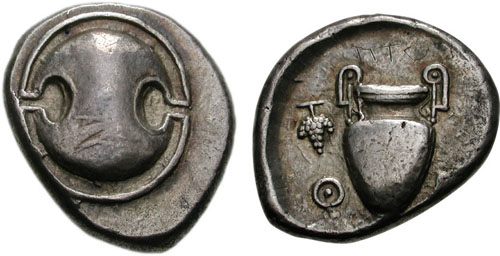SO 511 - Thebes over Elis
From SILVER
| Line 18: | Line 18: | ||
|Standard=Aeginetic | |Standard=Aeginetic | ||
|Coin reference=HGC 4, n°1325 | |Coin reference=HGC 4, n°1325 | ||
| − | |Coin series reference=Babelon | + | |Coin series reference=Babelon 1901-1932, Tome 3, Part 2, n°243-50; HGC 4, n°1325 |
|Coin series web reference=https://greekcoinage.org/iris/id/thebes.babelon_1914.243-50 | |Coin series web reference=https://greekcoinage.org/iris/id/thebes.babelon_1914.243-50 | ||
|Overstruck obverse description=Eagle flying left. | |Overstruck obverse description=Eagle flying left. | ||
Latest revision as of 15:12, 16 May 2024
425 BCE - 400 BCE | Θ-E
Images
Overstriking coin

Thebes_shield_amphora_and_grape.jpg [1]
Location/history
| Sale(s)Sale(s) ᵖ: | Classical Numismatic Groupe, Triton IX, 10 Jan. 2006, 397. | |
| Archaeological contextArchaeological context: | Distos Hoard (CH VII, 38). |
Overstriking coin
Description
| ObverseInscription or printing placed on the obverse.: | Boiotian shield. | ReverseInscription or printing placed on the reverse.: | Θ-E (Greek) Amphor. In field, grape bunch. All within incuse square. |
Mint and issuing power
| MintIdentifies the place of manufacture or issue of a numismatic object.: | Thebes | Ancient regionAncient region. | Boeotia | Modern countryModern country: Greece | AuthorityIdentifies the issuing power. The authority can be "pretended" when the name or the portrait of X is on the coin but he/she was not the issuing power. It can also be "uncertain" when there is no mention of X on the coin but he/she was the issuing power according to the historical sources: |
Chronology
| FromIdentifies the initial date in a range assigned in a numismatic context. 425 BCE toIdentifies the final date in a range assigned in a numismatic context.. 400 BCE | Classical 480-323 BC |
Physical description
| MetalThe physical material (usually metal) from which an object is made.: Silver |
WeightWeight of the numismatic object (in grams). in grams: 12.312.3 g <br />12,300 mg <br /> | DenominationTerm indicating the value of a numismatic object. Examples: tetradrachm, chalkous, denarius.: stater |
|
| StandardStandard.: Aeginetic | |||
References
| Coin referenceReference of the Coin: | HGC 4, n°1325 | Coin series referenceReference to coin series study: | Babelon 1901-19321Babelon 1901-1932, Tome 3, Part 2, n°243-50, HGC 42HGC 4, n°1325 |
| Coin series web referenceCoin series web references: | |||
Overstruck type
Description
| ObverseInscription or printing placed on the obverse.: | Eagle flying left. | ReverseInscription or printing placed on the reverse.: |
Mint and issuing power
| MintIdentifies the place of manufacture or issue of a numismatic object. ᵖ: | Elis | Ancient regionAncient region. ᵖ | Peloponnesus (Elis) | Modern countryModern country: Greece | AuthorityIdentifies the authority in whose name (explicitly or implicitly) a numismatic object was issued. ᵖ: |
Chronology
| FromIdentifies the initial date in a range assigned in a numismatic context. toIdentifies the final date in a range assigned in a numismatic context.. | Classical 480-323 BC |
Physical description
References
| Coin type referenceReference to coin series study ᵖ: |
Additional data
| Frequency of overstrikesFrequency of overstrikes: | frequent | Level of confidenceLevel of confidence of the identification: | |
| RemarksRemarks: | "Overstruck on an Elis-Olympia stater with eagle flying left on the obverse" | ||
References
- ^ Babelon, Ernest (1901-1932), Traité des monnaies grecques et romaines, Paris, E. Leroux
- ^ Hoover, Oliver D. (2014), Handbook of Greek Coinage Series 4. Northern and Central Greece : Achaia Phthiotis, Ainis, Magnesia, Malis, Oita, Perrhaibia, Thessaly, Akarnania, Aitolia, Lokris, Phokis, Boiotia, Euboia, Attica, Megaris and Corinthia, sixth to first centuries BC, Lancaster, lxxi, 563 p.